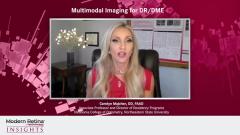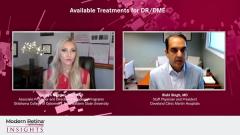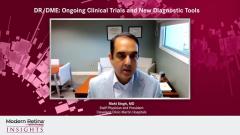
Available Treatments for DR/DME
Rishi Singh, MD, provides an overview of the various treatment options available for diabetic retinopathy and diabetic macular edema (DR/DME).
Episodes in this series

Carolyn Majcher, OD, FAAO:What are the various treatment options available for diabetic retinopathy and macular edema? Could you tell us a little about the benefits, limitations, long-term efficacy, and safety of each of those treatment options?
Rishi Singh, MD:We’ve had anti-VEGF therapy now for almost 12 years for diabetic macular edema [DME]. What we’ve learned is that anti-VEGF therapy is probably the gold standard: the best outcome with the lowest safety profile of any of the 3 drugs or other options we have. Because it has good efficacy and good safety, it really has been a game changer for us in this field. Think about that. In a 12-year span, we’ve been able to treat patients with this condition, which has been a huge benefit to our patients and our population in general.
We use steroids as a second-line option and sometimes a third-line option, with laser photocoagulation of the macula being important for patients with nonproliferative disease and diabetic macular edema. With proliferative disease, you have to go to the larger laser. You go to the panretinal laser with which you manage the entire retina and ablate the retina, but that’s not always necessary.
The way I measure patients’ vision in practice is first and foremost go by their baseline acuity to decide what I’m going to do. Then, given the anatomical parameters, I go along with that to follow the patient over time. For example, if the patient is 20/40 or better, I might consider them in a Protocol V category or Protocol T category depending on how bad their vision is. That’s the biggest driver for the final outcome of these patients, which has been important to see.
Carolyn Majcher, OD, FAAO:You touched on some of this already, but when should patients with diabetic retinopathy start anti-VEGF therapy or other treatments to improve vision or prevent vision loss?
Rishi Singh, MD:This has been a controversial topic in our field. For DME, the end result is clear. Everyone should get anti-VEGF therapy for that condition. We monitor with OCT [optical coherence tomography], see what the responses are, and start to tailor therapy based on that. For nonproliferative disease, there are few retina specialists I’m aware of who give in to the concept that preventing vision-threatening retinopathy complications is a good thing. I always think about it like it’s my eye or your eye, Dr Majcher. If you had this condition, is it easier to not suffer a vision-threatening retinopathy complication rather than [receive] a single injection in your eye maybe once every 2 to 3 months depending on which study results you’ve seen, what you evaluate, and what drug you’re using?
Overall, what I’ve been able to surmise is that we could be doing much better at using these treatment option approaches for patients. Yet we know that anti-VEGF therapy has the best long-term options for patients, the best efficacy and safety in that population, and has little benefits to risks. With steroids, there’s a concern about glaucoma, and we have to monitor for cataract progression as well. Finally, with photocoagulation, although it sounds easy enough to do, it can cause permanent scotomas to develop, problems with mydriasis or having the pupil dilate, and other issues that are related to the treatments themselves.
TRANSCRIPT EDITED FOR CLARITY
Newsletter
Keep your retina practice on the forefront—subscribe for expert analysis and emerging trends in retinal disease management.

















































